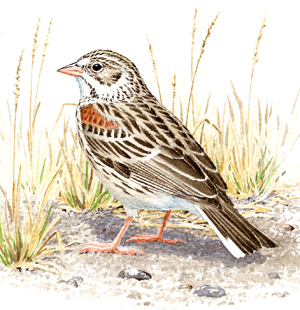Find a Bird
Vesper Sparrow
Pooecetes gramineus

Very local and strongly declining
Conservation action urgent
Threatened Species
“O quick quick quick, quick hear the song-sparrow, / Swamp-sparrow, fox-sparrow, vesper-sparrow / At dawn and dusk...” – T.S. Eliot, “Cape Ann”
Although it may sing at all hours of the day, the Vesper Sparrow is so named because of its tendency to sing well into the twilight hours. This dusk song corresponds to the traditional Catholic evening prayer service known as vespers. While Vesper Sparrows probably are not praying when they sing at dusk, they could certainly use any help they can get to keep them from becoming extirpated in Massachusetts. Like many grassland birds, Vesper Sparrows are struggling to find their place in a landscape increasingly ruled by forest and suburban sprawl, ground predators, and agricultural intensification.
Historic Status
If ever a bird suffered an identity problem in the eyes of humanity, it is the Vesper Sparrow. The species has been variously known through the years as Grass Finch, Bay-winged Bunting, and Bay-winged Sparrow before its current name was finally established. By whatever appellation, the species was once relatively common in Massachusetts and was known to the early settlers who cleared the forests to make farm fields. Modern observers are given pause by Edward Howe Forbush’s early twentieth century description of the species as “next to the Song Sparrow, the most abundant Ground Sparrow in Massachusetts,” (Forbush 1907). Vesper Sparrows began a slow decline in the 1940s, when the effects of farm abandonment became increasingly apparent.
Atlas 1 Distribution
By the time of Atlas 1, Vesper Sparrows were still broadly distributed across the state of Massachusetts. However, their actual breeding sites were diffuse and scattered, and they were only found in 53 blocks, or 6% of the state. All the regions west of the Connecticut River Valley combined yielded only 6 Probable breeding sites. The Connecticut River Valley itself supported among the highest block occupancy rates by far at 30%, thanks to its abundance of large pastures and other agricultural habitats. The sparrows were present but quite local as breeders across the Worcester Plateau and the Coastal Plains, appearing only at the largest farms, airfields, or open coastal heathlands. The Boston Basin had no grasslands of suitable size, and the Bristol/Narragansett Lowlands reported only a single occupied block. The Cape and Islands supported 25% of the statewide occupied blocks, mostly concentrated in extensive sandplain heathlands and grasslands.
Atlas 2 Distribution and Change
How the mighty have fallen! The Vesper Sparrow was recorded in just 2% (21) of all surveyed blocks in Atlas 2, despite thousands of hours of effort to locate their breeding areas across Massachusetts, and despite their status as a Threatened Species in the state. The Vesper Sparrow population was already vanishing In Atlas 1, but by Atlas 2 the species had reached a critical point. Despite scattered records throughout the state, this grassland nester now maintains only two historic strongholds: the Connecticut River Valley and Cape Cod. Both regions have apparently, however, become unable to sustain the species, judging by the negative trends in its distribution.
Atlas 1 Map

Atlas 2 Map

Atlas Change Map

Ecoregion Data
Atlas 1 | Atlas 2 | Change | ||||||
Ecoregion | # Blocks | % Blocks | % of Range | # Blocks | % Blocks | % of Range | Change in # Blocks | Change in % Blocks |
Taconic Mountains | 0 | 0.0 | 0.0 | 0 | 0.0 | 0.0 | 0 | 0.0 |
Marble Valleys/Housatonic Valley | 2 | 5.1 | 3.8 | 0 | 0.0 | 0.0 | -2 | -5.1 |
Berkshire Highlands | 1 | 1.8 | 1.9 | 1 | 1.8 | 4.8 | 0 | 0.0 |
Lower Berkshire Hills | 0 | 0.0 | 0.0 | 0 | 0.0 | 0.0 | 0 | 0.0 |
Vermont Piedmont | 2 | 11.8 | 3.8 | 0 | 0.0 | 0.0 | -2 | -16.7 |
Berkshire Transition | 1 | 2.6 | 1.9 | 0 | 0.0 | 0.0 | -1 | -3.2 |
Connecticut River Valley | 17 | 30.4 | 32.1 | 7 | 10.8 | 33.3 | -12 | -25.0 |
Worcester Plateau | 5 | 6.4 | 9.4 | 0 | 0.0 | 0.0 | -5 | -10.4 |
Lower Worcester Plateau | 4 | 5.4 | 7.5 | 1 | 1.3 | 4.8 | -3 | -5.6 |
S. New England Coastal Plains and Hills | 7 | 2.6 | 13.2 | 4 | 1.4 | 19.0 | -4 | -1.8 |
Boston Basin | 0 | 0.0 | 0.0 | 1 | 1.8 | 4.8 | 1 | 1.8 |
Bristol and Narragansett Lowlands | 1 | 0.9 | 1.9 | 2 | 1.8 | 9.5 | 1 | 1.0 |
Cape Cod and Islands | 13 | 9.6 | 24.5 | 5 | 3.5 | 23.8 | -9 | -7.5 |
Statewide Total | 53 | 5.5 | 100.0 | 21 | 2.0 | 100.0 | -36 | -4.3 |
Notes
In accordance with Atlas decreases, the Vesper Sparrow shows significant decreasing Breeding Bird Survey trends in the New England/Mid-Atlantic Region and in the Eastern US overall.



